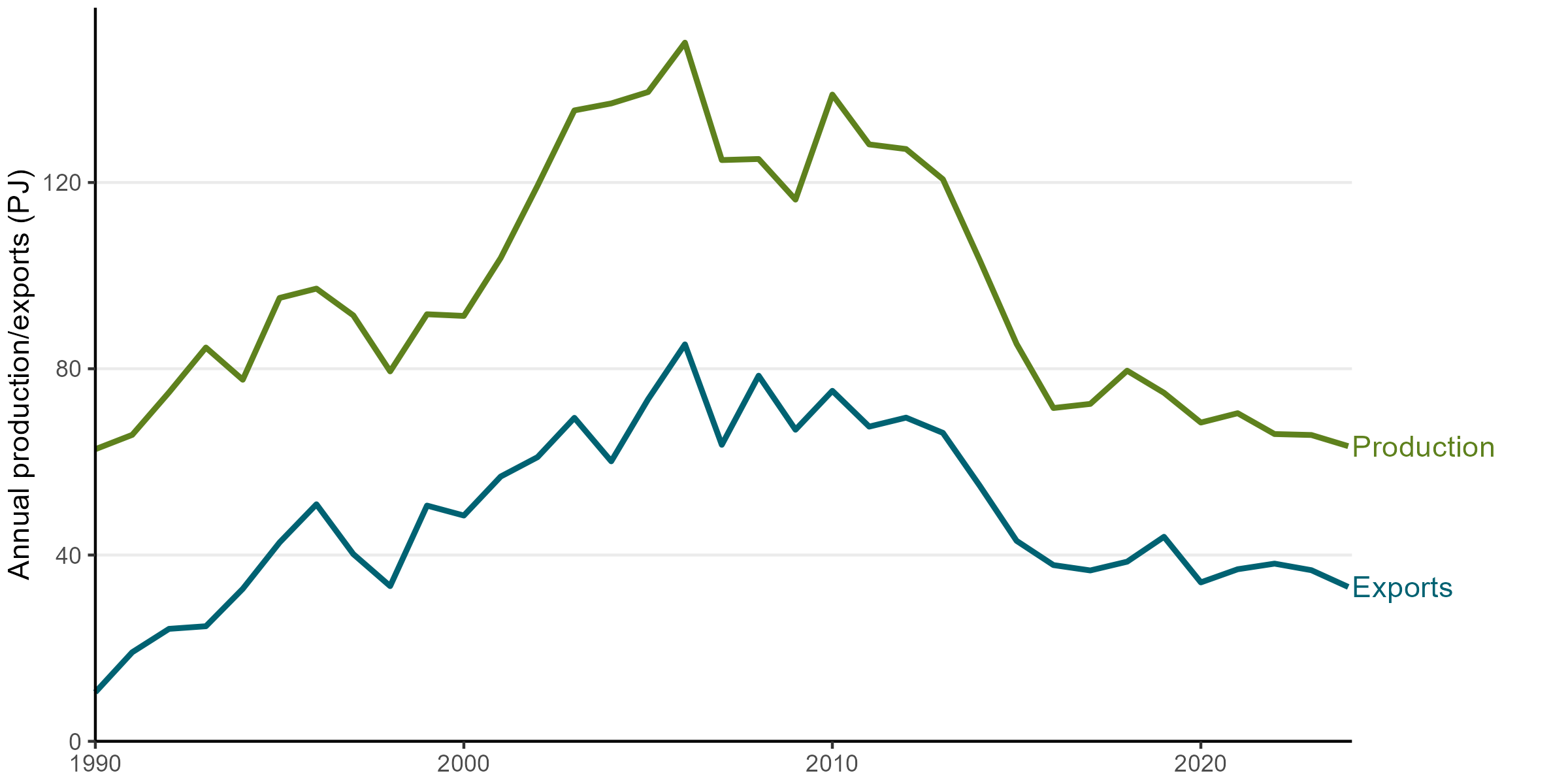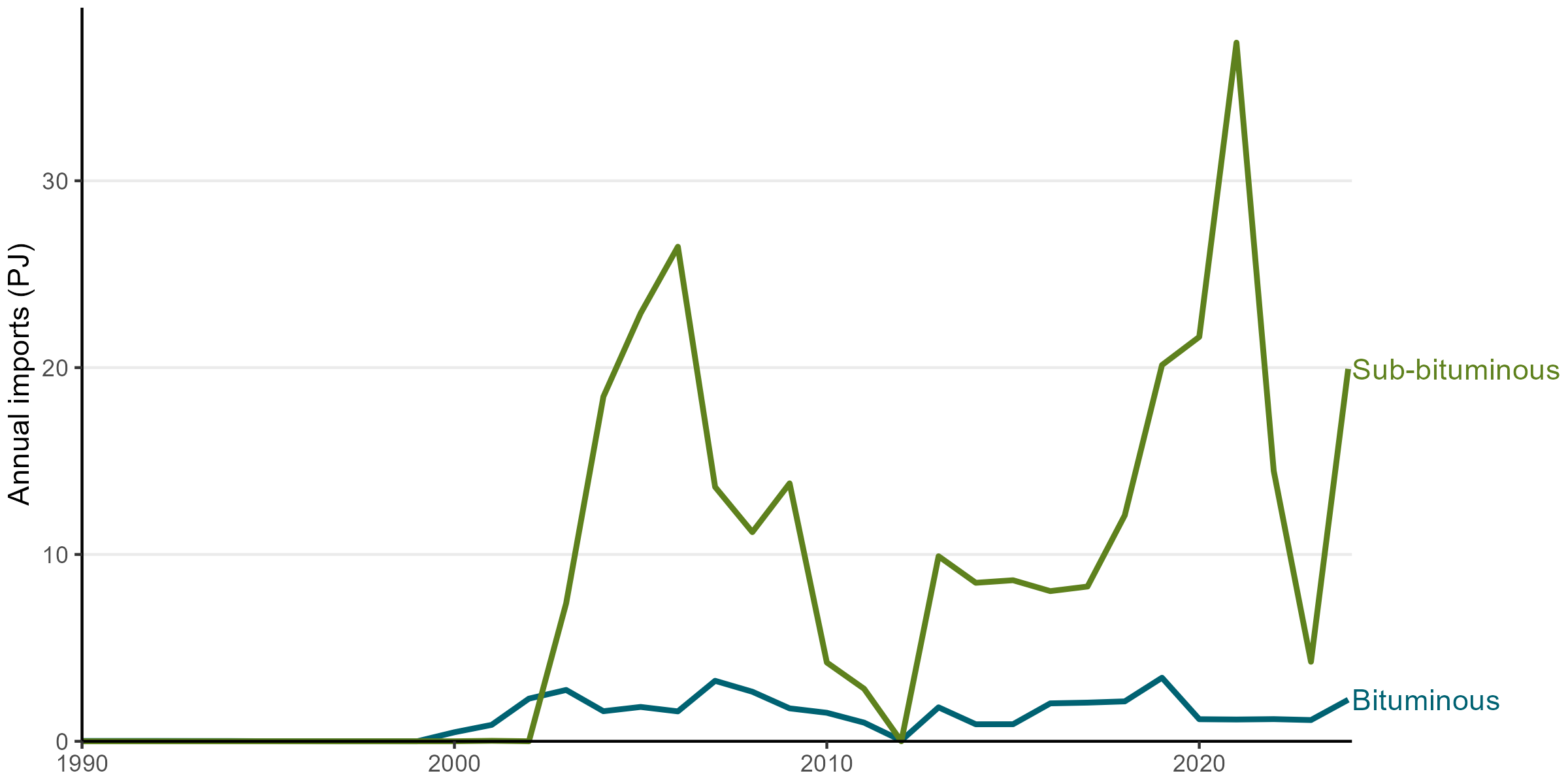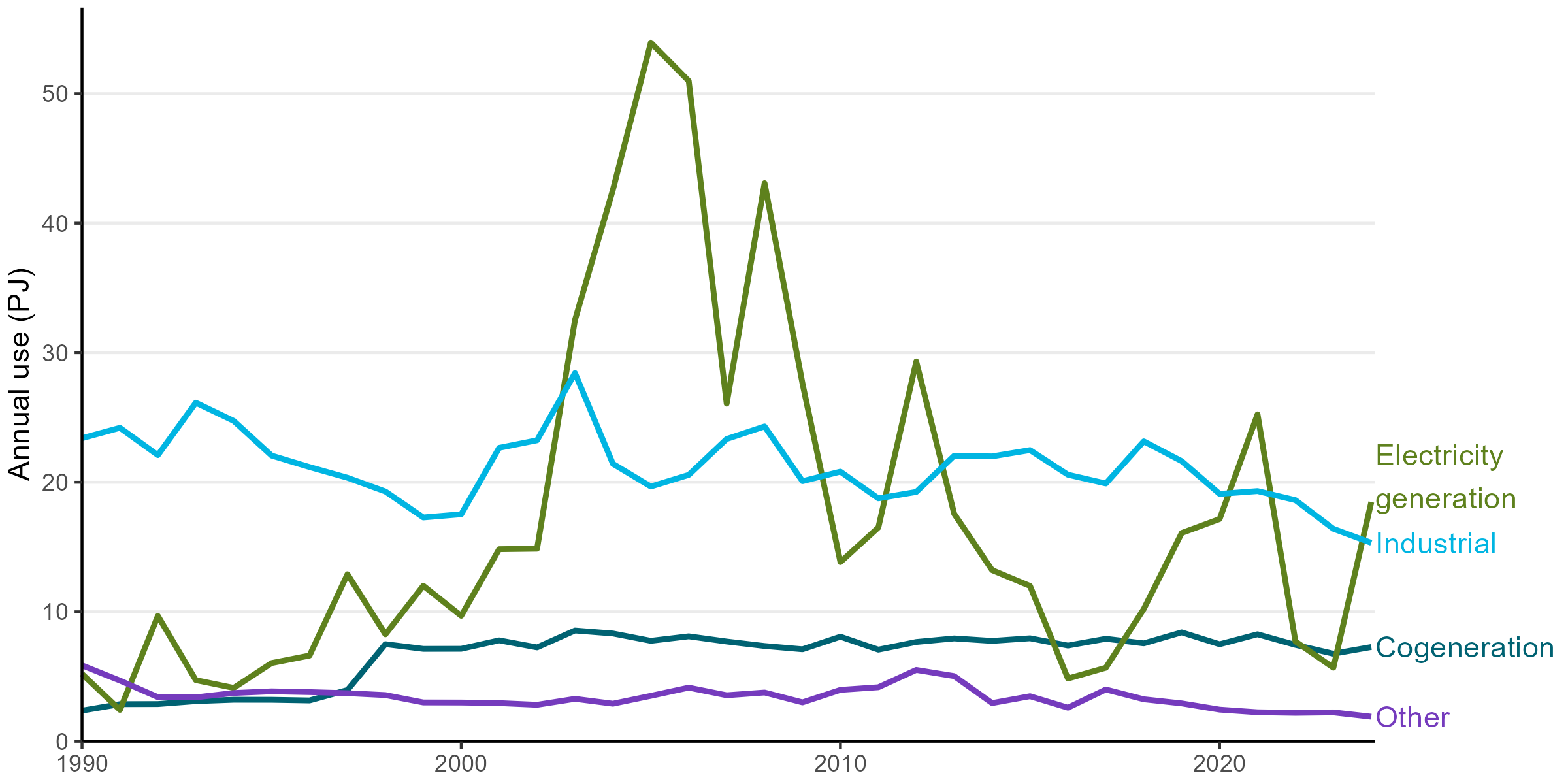Coal
Slips and a partial tunnel collapse disrupted both exports and production of coal in 2024. At the same time, coal imports increased as Genesis rebuilt its stockpile at the Huntly Power Station.
On this page I tēnei whārangi
While coal use for electricity generation increased in 2024, use in other applications continued to decline, primarily driven by lower industrial coal consumption.
Background
New Zealand has extensive coal resources, mainly in the Waikato and Taranaki regions of the North Island, the West Coast, Otago, and Southland regions of the South Island.
New Zealand’s coal market can be divided into three distinct geological areas:
- In the North Island, coal production is centred in the Waikato region where large coalfields produce sub-bituminous coal. This coal is suitable for heating and electricity generation, but it is generally not high enough quality to be used in metallurgical applications (that is, the production of iron and steel). One of the main users of this coal is the steel mill in Glenbrook, south-east of Auckland. Unlike other steel mills, the Glenbrook mill can use thermal-grade coal in the production of iron and steel due to the unique processes employed at the facility.
- Most coal extracted on the West Coast of the South Island is generally classified as bituminous, which has higher energy content than the sub-bituminous coal mined in the North Island. Most of this bituminous coal is exported for use in the production of iron and steel. Sub-bituminous coal from the West Coast is used locally or within the northern half of the South Island.
- The rest of the South Island tends to produce either sub-bituminous coal or the even lower-energy lignite. Lignite has a lower energy content and is generally sold to dairy and meat processing plants in the South Island and to households and companies for heating.
Coal is used in New Zealand for energy use: the coal is burned to provide heat whether that heat is used to dry milk powder, power a steam engine, run a boiler, or heat a house.
There are also two other major uses of coal in New Zealand:
- At the Huntly Power Station, the energy in the combusted coal is used to drive turbines which generate electricity.
- At the Glenbrook steel mill, coal is used as a reducing agent converting magnetite in ironsand to metallic iron. While it may provide energy, its primary purpose is as a reagent in a chemical reaction meaning that it is not classified as energy use.
Coal production and exports fall due to closures of transport routes
Coal production and exports fell in 2024, with the closure of a major transport route contributing to this. In June 2024, the Tawhai Tunnel on the route between the Stockton mine to Lyttleton Port was closed following a partial collapse. This led to the closure of the rail line linking the mine and the port, a main route for moving export-bound coal. The closure of the tunnel for the rest of 2024 saw road-based freight being used to bypass the tunnel, although this was at a lower volume. October 2024 saw further disruptions to supply routes, with a slip in the Buller Gorge causing the rail line to fully close for several weeks.
The rail line closures also meant coal could not be sent down from the mines via the aerial transport system to the rail loading facilities[6]. As a result, production was limited whenever the rail line was not operational, which impacted production volumes for the year as well.
Coal production in 2024 fell 3.64% from 65.78 PJ in 2023 to 63.38 PJ in 2024. Exports also fell by 9.78%, from 36.74 PJ to 33.15 PJ, reflecting the reduced capacity to transport coal to ports and international markets (Figure 12).

Figure 12. Total coal production and exports, by year.
View chart data for figure 12
Gas supply uncertainty leads to coal stockpile increase
Genesis’ Huntly Power Station, New Zealand’s only coal-fired power plant, sources most of its coal from mines in Indonesia. Uncertainty around domestic gas supply saw Genesis announce in May 2024 that it would resume imports of coal to increase its stockpile[7]. As a result, coal imports increased by 311% up from 5.39 PJ in 2023 to 22.15 PJ in 2024 (Figure 13). The majority of this was sub-bituminous coal, the type used at Huntly. Imports of bituminous coal, which is typically used in industrial manufacturing, also increased, nearly doubling from 1.14 PJ in 2023 to 2.22 PJ in 2024.

Figure 13. Coal imports by year and energy type. New Zealand does not import lignite.
View chart data for figure 13
Coal use for electricity increases, but other use continues downward trend
Electricity generation from coal saw a large increase in 2024, driven by a combination of unfavourable hydro conditions and lower gas supply. Coal use in electricity generation rose by 225%, from 5.68 PJ in 2023 to 18.47 PJ in 2024, more than tripling year-on-year.
Coal used in the rest of the economy continued its long-term decline, falling from 18.64 PJ in 2023 to 17.22 PJ in 2024. This was primarily driven by reductions in industrial use.
Industrial coal consumption dropped from 16.41 PJ to 15.32 PJ (Figure 14). Contributing to this is a reduction in coal use for food manufacturing. Notably, Fonterra has been transitioning away from coal in its manufacturing processes, with coal boilers at several of its facilities being replaced by electrode boilers or switching to using wood pellets. Their last coal boiler in the North Island was turned off in November 2024.
Coal used in steel production, another major use of coal in New Zealand, experienced a slight decrease from 9.68 PJ to 9.45 PJ. The agriculture, forestry, and fishing sector also saw a modest decline in coal use, from 1.61 PJ to 1.40 PJ, while residential consumption remained relatively stable.

Figure 14. Coal use by sector and year.
View chart data for figure 14
Footnotes
[6] Bathurst Resources Limited 2024 Annual Report
Financial Reports(external link) — Bathurst Resources Ltd
[7] Genesis increases coal stockpile for winter amid gas shortage(external link) — Genesis NZ

